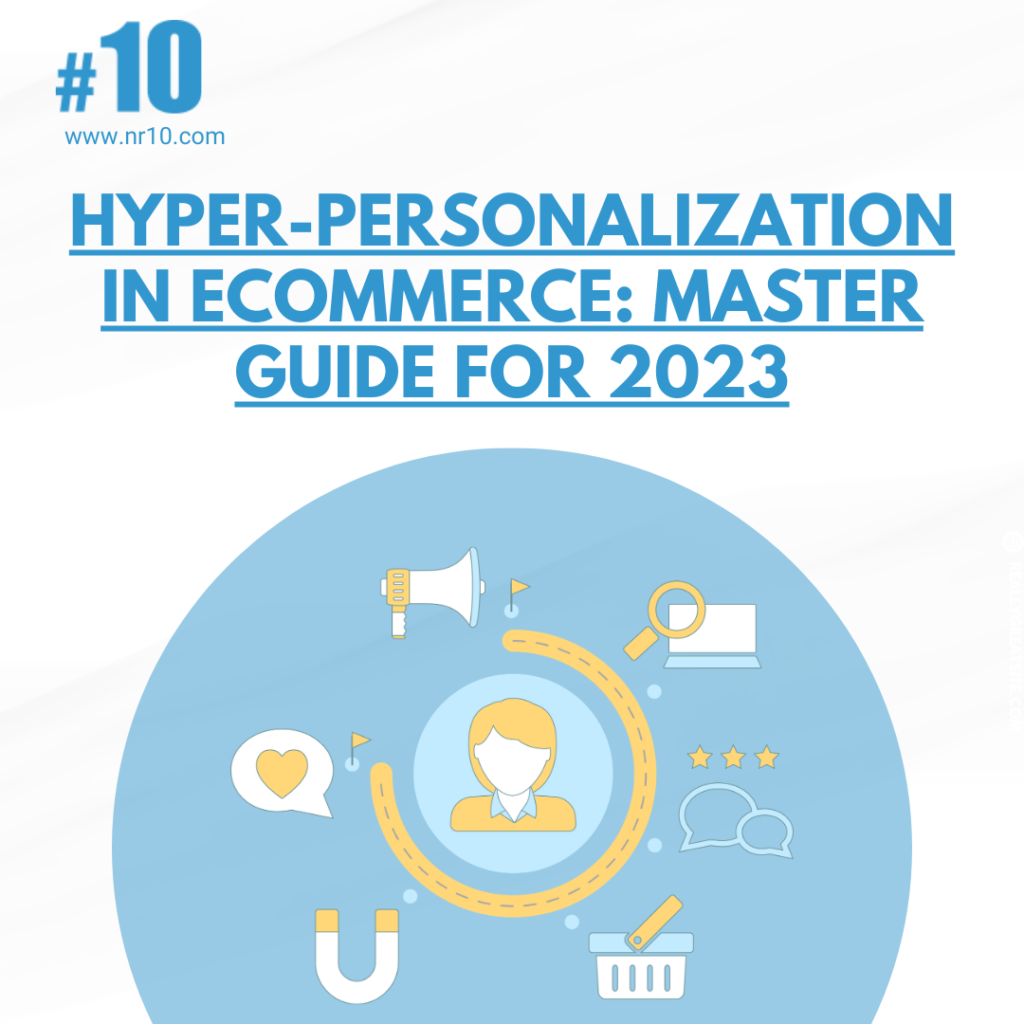Q1: What is hyper-personalization in e-commerce and how does it differ from personalization?
Q2: How does hyper-personalization benefit customers and businesses in ecommerce?
Q3: What are the key steps to implement hyper-personalization in an ecommerce business?
Q4: What technologies are vital for achieving hyper-personalization in ecommerce?
Q5: How does hyper-personalization align with privacy laws and regulations?
Q6: What are the risks and challenges associated with implementing hyper-personalization in ecommerce?
Q7: What are the best practices for implementing hyper-personalization in ecommerce?
Q8: How do I measure the success of hyper-personalization strategies in ecommerce?
Q9: Can hyper-personalization work in a small ecommerce business, and how can it be scaled?
Q10: What are some successful real-world examples of hyper-personalization in ecommerce?
Hyper-Personalization vs Personalization in E-commerce
Hyper-personalization in e-commerce is the use of real-time data and advanced technologies like artificial intelligence (AI) to provide a highly customized and individualized shopping experience. This advanced form of personalization goes beyond traditional personalization methods that segment customers into large groups based on shared characteristics. Instead, hyper-personalization focuses on the individual preferences and behaviors of each customer.
For e-commerce businesses, implementing hyper-personalization can greatly enhance the shopping experience for customers. It allows businesses to deliver relevant product recommendations and content, improve website navigation, and streamline the overall purchase process. This degree of personalization makes each customer feel valued and understood, leading to higher customer satisfaction and loyalty.
Unlike hyper-personalization, traditional personalization in e-commerce uses a more general approach. It segments customers into groups based on shared characteristics like geographic location, age, or past purchase behavior. These segmented groups are then targeted with specific marketing messages and product recommendations. While personalization does improve the shopping experience compared to a one-size-fits-all approach, it does not offer the same level of individualized attention as hyper-personalization.
The main difference between hyper-personalization and personalization lies in the depth and accuracy of the customer data used. Hyper-personalization relies on real-time data collected from various touchpoints along the customer journey. This includes browsing behavior, purchase history, social media interactions, and other online activities. This wealth of data enables a deep understanding of each customer’s unique needs, preferences, and shopping behavior.
On the other hand, traditional personalization may rely on more static and general customer data. This could include demographic information and past purchase history, but it often does not take into account real-time behaviors or individual preferences to the same extent. As a result, while personalization does improve the shopping experience to a degree, it may not fully capture the individuality of each customer.
The shift from personalization to hyper-personalization in e-commerce reflects the ongoing advancements in technology and data analytics. As businesses gain access to more data and more powerful analytic tools, they can better understand their customers and offer a more personalized shopping experience. However, implementing hyper-personalization does require a significant investment in technology and data management, as well as a strong commitment to customer privacy.
In conclusion, both personalization and hyper-personalization play important roles in enhancing the e-commerce shopping experience. While personalization offers a more tailored shopping experience than a one-size-fits-all approach, hyper-personalization takes this a step further by offering a highly individualized experience based on real-time data and advanced analytics. By understanding the differences between these two approaches, e-commerce businesses can make informed decisions about how best to engage their customers and meet their unique needs.
For more related information, you may refer to What’s the goal of A/B testing?, which helps measure the effectiveness of your hyper-personalization efforts.
Benefits of Hyper-Personalization in E-commerce
Hyper-personalization offers several benefits to both e-commerce businesses and their customers. Let’s break these down to understand the tangible impact better.
From a customer’s perspective, hyper-personalization provides a more relevant, efficient, and engaging shopping experience. The individualized content and product recommendations based on their unique preferences and behavior significantly increase the chances of discovering products they’re interested in, thereby reducing the time spent searching.
Moreover, a hyper-personalized shopping experience is also more engaging. It gives customers the feeling that the e-commerce site ‘knows’ them and can anticipate their needs, fostering a sense of appreciation and customer loyalty. This personalized attention can significantly enhance the overall shopping experience, leading to higher customer satisfaction.
On the other hand, e-commerce businesses can reap considerable benefits from hyper-personalization. It can lead to increased sales and revenue by effectively targeting individual customer preferences, increasing the likelihood of product discovery and purchase.
Hyper-personalization also improves conversion rates. By presenting the most relevant products and content to each visitor, businesses can significantly increase the chances of turning a casual browser into a paying customer. Furthermore, a more engaging and efficient shopping experience can also enhance customer retention and loyalty, which leads to more repeat purchases and higher customer lifetime value.
Businesses can also gain valuable insights from the rich data gathered for hyper-personalization. They can use these insights to continuously refine their product offerings, marketing strategies, and overall business operations. This level of detail can provide businesses with a significant competitive advantage in the increasingly crowded e-commerce landscape.
However, implementing hyper-personalization does require a significant investment in advanced technologies like AI and data analytics tools. Businesses must also consider the implications for data privacy and ensure they are adhering to all relevant laws and regulations.
Despite these challenges, the potential benefits of hyper-personalization for both e-commerce businesses and customers make it a worthwhile investment. With careful planning and implementation, businesses can use hyper-personalization to create a more engaging shopping experience, increase sales, and build stronger relationships with their customers.
For understanding the technical aspect, please visit Native Mobile App vs Responsive Website for Magento, which helps in the overall understanding of how these systems contribute to a personalized shopping experience.
Implementing Hyper-Personalization in E-commerce
Implementing hyper-personalization in e-commerce involves several key steps. This process requires a clear strategy, access to the right technologies, and a focus on continuous learning and improvement.
The first step in implementing hyper-personalization is to have a clear understanding of your customers. This involves collecting and analyzing customer data from a variety of sources such as transaction histories, browsing behavior, customer feedback, and more. It’s important to remember that for hyper-personalization to be effective, you need to understand individual customer preferences and behaviors rather than simply segmenting customers into broad groups.
Next, you need to invest in the right technologies. Implementing hyper-personalization requires sophisticated data analytics capabilities and artificial intelligence (AI) tools. These technologies allow you to analyze large amounts of customer data in real-time, identify patterns, and make highly individualized product recommendations.
Creating personalized content is another crucial aspect of hyper-personalization. This could involve tailoring product descriptions and reviews, personalizing marketing messages, or offering individualized product recommendations based on a customer’s previous purchases or browsing behavior.
Once you’ve started implementing hyper-personalization, it’s essential to continuously test, learn, and improve your approach. This could involve A/B testing different personalization strategies, collecting customer feedback, and using advanced analytics to measure the impact of your efforts. Learn more about A/B testing by visiting What’s the Goal of A/B Testing?
Finally, it’s important to remember that while hyper-personalization can provide significant benefits, it should not be implemented at the expense of customer privacy. E-commerce businesses must ensure they are collecting and using customer data in a way that is transparent, secure, and compliant with relevant data protection laws.
To sum up, implementing hyper-personalization in e-commerce involves a deep understanding of your customers, investing in the right technologies, creating personalized content, continuously learning and improving, and respecting customer privacy. These steps, while complex, can provide significant benefits in terms of improved customer experience, increased sales, and higher customer loyalty.
Key Technologies for Hyper-Personalization in E-commerce
Hyper-personalization in e-commerce hinges on leveraging various technologies to gather, process, and utilize customer data effectively. Let’s take a look at the key technologies vital for achieving hyper-personalization in e-commerce.
The backbone of hyper-personalization is data, and to handle the vast amount of data, robust Data Management Platforms (DMPs) are crucial. DMPs collect, sort, and store data from various sources, providing a unified customer view. They’re pivotal for identifying patterns, segmenting customers, and creating detailed customer profiles.
Artificial Intelligence (AI) plays a key role in achieving hyper-personalization. AI can analyze vast amounts of data in real-time and derive meaningful insights from it. Machine learning, a subset of AI, can further learn from these data points, predict future behaviors, and automate personalization processes.
Along with AI, Predictive Analytics tools are crucial for forecasting customers’ future behaviors and preferences based on their past actions. These tools aid in understanding which products or services a customer is likely to be interested in, enabling real-time customization.
Content Management Systems (CMS) are pivotal to delivering personalized content. A CMS enables businesses to create, manage, and modify content based on individual customer profiles. This technology helps deliver dynamic content that aligns with a customer’s specific needs and preferences.
Customer Relationship Management (CRM) systems also play a role by organizing and managing customer data, helping businesses understand their customers better and deliver more personalized experiences.
E-commerce platforms and tools designed for personalization, like Magento, also play a role in delivering a hyper-personalized experience. By combining these tools with other technologies, e-commerce businesses can offer a highly personalized shopping experience.
Lastly, A/B testing tools are essential for evaluating the effectiveness of different personalization strategies. They allow businesses to test variations of their website or marketing campaigns to determine which version resonates best with their customers. Learn more about A/B testing by visiting What’s the Goal of A/B Testing?
In conclusion, a wide range of technologies are pivotal for achieving hyper-personalization in e-commerce, including Data Management Platforms, AI, Predictive Analytics, CMS, CRM systems, e-commerce platforms, and A/B testing tools.
Hyper-Personalization and Privacy Laws in E-commerce
In the era of hyper-personalization, e-commerce businesses are collecting, storing, and analyzing more customer data than ever before. While this provides opportunities for enhanced personalization, it also brings potential risks and responsibilities in terms of privacy and data protection.
The primary privacy law affecting e-commerce businesses globally is the General Data Protection Regulation (GDPR) in the European Union. Under GDPR, businesses are required to obtain explicit consent from customers before collecting their data. They must also provide customers with clear information about how their data will be used and provide them with the right to access, correct, and delete their data.
Hyper-personalization strategies need to align with these requirements. This means being transparent about data collection practices, only collecting data that is necessary for personalization, and providing mechanisms for customers to control their data.
Another relevant regulation is the California Consumer Privacy Act (CCPA), which applies to businesses operating in California, USA. Like GDPR, CCPA requires businesses to be transparent about data collection and use and provides consumers with the right to control their data.
In addition to these laws, e-commerce businesses must consider various industry-specific regulations and standards, such as the Payment Card Industry Data Security Standard (PCI DSS) for businesses that handle credit card data.
Implementing hyper-personalization also means being vigilant about data security. E-commerce businesses must have robust security measures in place to protect customer data from breaches and cyberattacks. This includes encrypting sensitive data, regularly testing and updating security systems, and having a plan in place to respond to data breaches.
It’s also worth noting that while privacy laws and regulations may seem like a challenge, they can also provide opportunities for e-commerce businesses. By demonstrating a commitment to privacy and data protection, businesses can build trust with customers and enhance their reputation.
To sum up, aligning hyper-personalization with privacy laws and regulations involves transparency about data collection and use, giving customers control over their data, ensuring data security, and complying with relevant laws and standards.
Risks and Challenges in Implementing Hyper-Personalization in E-commerce
Hyper-personalization is a powerful strategy for enhancing customer experience and boosting e-commerce sales, but it’s not without its challenges and potential risks. Here’s a closer look at what e-commerce businesses might face while implementing hyper-personalization.
One of the foremost challenges in implementing hyper-personalization is data management. Gathering, organizing, and analyzing vast amounts of customer data can be a daunting task. It requires sophisticated technology and skills, which may not be readily available to all businesses.
Data privacy is another significant challenge. As we’ve covered in the previous section, businesses must navigate various data privacy laws and regulations, and any misstep can lead to substantial fines and damage to the brand’s reputation.
Data security is a related challenge. With businesses collecting more data than ever before, they become attractive targets for cybercriminals. Ensuring the security of customer data is a paramount concern.
Another risk associated with hyper-personalization is the potential for creating a ‘creepy’ customer experience. If personalization is too intrusive or intense, it may make customers uncomfortable and lead them to abandon the business.
The technology involved in hyper-personalization can also pose a challenge. Implementing and integrating various technologies like AI, predictive analytics, and data management platforms can be complex and require significant resources.
There’s also the challenge of maintaining a balance between personalization and the scalability of your e-commerce business. As you grow and acquire more customers, delivering a unique experience to each one can become increasingly difficult.
Finally, measuring the success of hyper-personalization strategies can be a challenge. It’s essential to establish clear metrics and KPIs to assess the impact of personalization strategies on your business.
To conclude, while hyper-personalization offers many benefits, it also comes with its set of risks and challenges. Data management, privacy and security, customer comfort, technology, scalability, and measurement are all areas that businesses need to address when implementing hyper-personalization.
Best Practices for Implementing Hyper-Personalization in E-commerce
Now that we’ve explored the risks and challenges, let’s look at the best practices for implementing hyper-personalization in e-commerce. These guidelines can help businesses maximize the benefits of personalization while mitigating the associated risks and challenges.
- Be transparent about data collection and use: Make sure you communicate clearly with your customers about what data you’re collecting, why you’re collecting it, and how it’s being used. Provide them with control over their data, and ensure you’re complying with all relevant privacy laws and regulations.
- Prioritize data security: Protect your customers’ data as if it were your own. Implement robust security measures, regularly update and test your security systems, and have a plan in place to respond to data breaches.
- Use AI and machine learning wisely: These technologies are crucial for analyzing customer data and delivering personalized experiences. However, ensure you’re using them in a way that enhances the customer experience, rather than making it feel intrusive or ‘creepy.’
- Focus on quality, not quantity: When it comes to data, more isn’t always better. Focus on collecting high-quality, relevant data that can genuinely enhance personalization, rather than trying to gather as much data as possible.
- Test and refine your strategies: Just like with any other marketing strategy, A/B testing can be incredibly useful for refining your personalization strategies. Test different approaches, learn from the results, and continuously refine your strategies based on your findings.
- Maintain a human touch: Even as you use advanced technology to personalize the customer experience, don’t forget the importance of the human touch. Make sure your communications still feel genuine and human-centric.
- Measure your success: Establish clear metrics and KPIs to measure the success of your personalization strategies. Continuously monitor these metrics and use them to inform your ongoing strategies.
By adhering to these best practices, e-commerce businesses can reap the benefits of hyper-personalization while minimizing potential risks and challenges.
Measuring the Success of Hyper-Personalization Strategies in E-commerce
Quantifying the impact of hyper-personalization strategies is crucial for understanding their effectiveness and guiding future marketing efforts. So, what metrics should you track to measure the success of your hyper-personalization strategies?
One of the most direct ways to measure the success of hyper-personalization is through conversion rates. A higher conversion rate could indicate that your personalization strategies are resonating with customers and driving them to make purchases.
Another critical metric is average order value (AOV). If your personalization strategies are successful, you might see an increase in AOV as customers find more relevant products and make larger purchases.
Customer retention rates can also indicate the success of hyper-personalization. By providing a more personalized experience, you can build stronger relationships with your customers and increase their loyalty to your brand.
In addition to these direct metrics, you can also measure success indirectly through customer feedback and satisfaction scores. Positive customer reviews and high satisfaction scores can reflect the effectiveness of your personalization efforts.
It’s also essential to measure the ROI of your personalization strategies. Compare the cost of implementing and maintaining your hyper-personalization strategies with the increased revenue they bring in.
Lastly, track the usage of personalized features on your e-commerce site. If customers are frequently using these features, it suggests they find them valuable.
To get a comprehensive view of your personalization efforts’ effectiveness, consider using a combination of these metrics. Remember, what matters most are the metrics that align with your overall business goals and objectives.
Hyper-Personalization in Small E-commerce Businesses: Feasibility and Scaling
When we think about hyper-personalization, we often think about large e-commerce giants with the resources to invest in AI and machine learning. However, hyper-personalization isn’t exclusive to big businesses. Even small e-commerce businesses can leverage it effectively.
Small businesses might not have the large customer base of a corporation, but they often have a more intimate understanding of their customers. This knowledge can be used to implement personalized recommendations, emails, and content, enhancing customer experience and engagement.
Tools and platforms available today make it easier for small businesses to implement hyper-personalization. Platforms like Shopify or Magento offer plug-ins and tools that allow businesses to leverage customer data and create personalized experiences. Here is a detailed comparison of a native mobile app vs a responsive website for Magento to help you understand the choices you have for your e-commerce platform.
Small businesses can start by personalizing emails based on purchase history or browsing behavior. Later, they can implement personalized product recommendations or personalized content on their website or app.
The scalability of hyper-personalization is another aspect small businesses need to consider. As your business grows, you’ll collect more customer data, which can be leveraged for more refined personalization. Your personalization strategies should thus be flexible and adaptable, allowing you to accommodate and leverage this increase in data.
The use of AI and machine learning can also help with scaling. These technologies can automate the process of analyzing customer data and delivering personalized experiences, making them more manageable as your business and customer base grow.
Therefore, not only can hyper-personalization work in small e-commerce businesses, but it can also be a powerful tool for growth and scaling.
Real-world Examples of Successful Hyper-Personalization in E-commerce
Hyper-personalization in e-commerce has become the norm in recent years, with many leading companies successfully implementing it to enhance their customer experience. Let’s explore a few of these success stories.
1. Amazon
Amazon is one of the pioneers of hyper-personalization in e-commerce. They use customer data to recommend products based on browsing and purchasing history, leading to a more relevant shopping experience for each user.
2. Netflix
Netflix uses hyper-personalization to recommend shows and movies based on a user’s viewing history. Their recommendation engine not only looks at what a user has watched but also considers their viewing behavior (like whether they watched a show completely or skipped it halfway).
3. Spotify
Spotify’s Discover Weekly and Daily Mix playlists are perfect examples of hyper-personalization. These playlists are curated based on each user’s listening history, providing a unique, personalized listening experience for every user.
4. Stitch Fix
Stitch Fix, an online personal styling service, uses AI to personalize clothing recommendations for each customer. Customers receive hand-picked clothing items based on their style profile, preferences, and feedback, providing a highly personalized shopping experience.
5. Sephora
Beauty retailer Sephora uses hyper-personalization in their mobile app. The app offers personalized product recommendations, beauty tips, and tutorials based on each user’s beauty preferences and purchase history.
These real-world examples showcase how successful implementation of hyper-personalization can significantly enhance the user experience, leading to higher engagement, customer satisfaction, and ultimately, business growth.
To summarize, hyper-personalization in e-commerce, when done right, can be a game-changer. It not only enhances the customer experience but also improves business metrics like conversion rates and average order value. As we move towards a more digitized world, hyper-personalization will continue to play a crucial role in shaping the future of e-commerce.
Always remember, the objective of your hyper-personalization strategy, similar to A/B testing, should be to learn more about your customers, cater to their unique needs, and provide a seamless and delightful shopping experience.
| Topic | Summary |
|---|---|
| Definition | Hyper-personalization is advanced personalization using real-time data and AI. |
| Benefits | Enhances customer experience, boosts sales, improves conversion rates, and enhances customer loyalty. |
| Implementation | Steps include data collection, analysis, using AI and machine learning, and delivering personalized content. |
| Technologies | Key technologies include AI, machine learning, data analytics tools, and CRM systems. |
| Privacy Considerations | Must respect privacy laws, obtain customer consent, disclose data use, and protect customer data. |
| Risks and Challenges | Include privacy violations, data management, inaccuracies, and technology management. |
| Best Practices | Include setting clear goals, using right data and technologies, testing, respecting privacy, and refining strategies. |
| Success Measurement | Measured through conversion rates, order value, customer retention, satisfaction scores, and A/B testing. |
| Scalability | Can be scaled in small businesses by leveraging AI, automating data analysis, and continuous optimization. |
| Real-World Examples | Examples include Amazon, Netflix, Spotify, Stitch Fix, and Sephora. |





